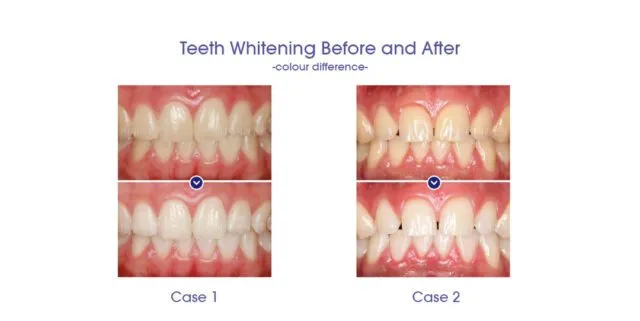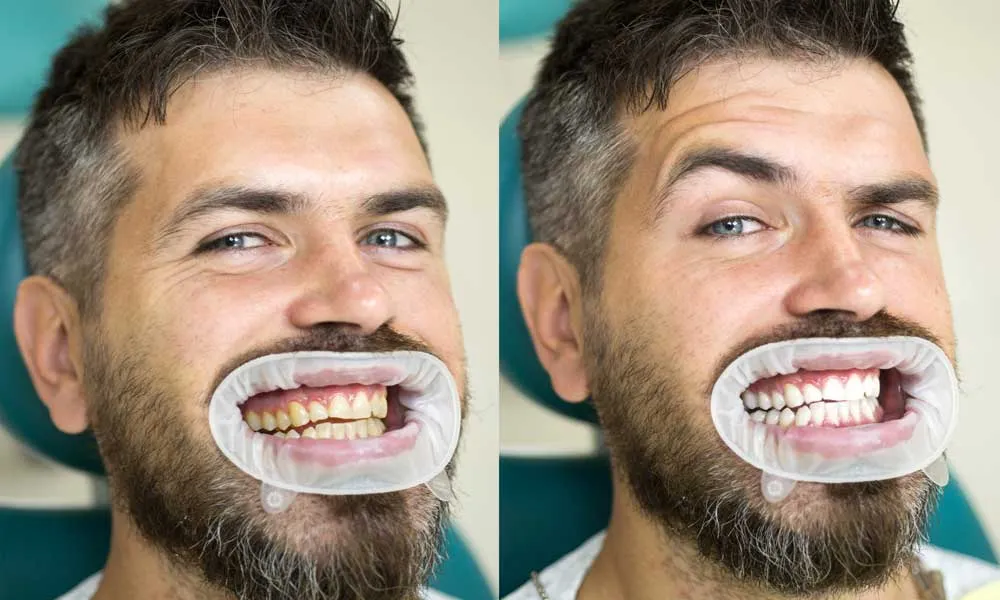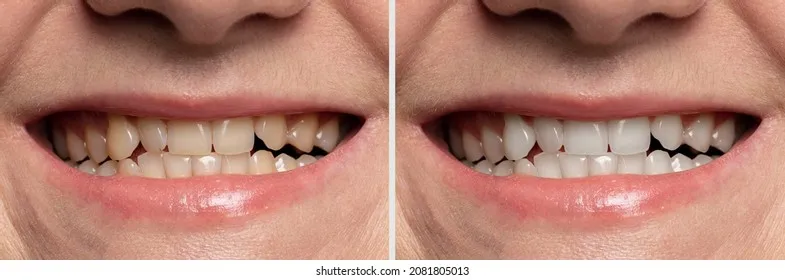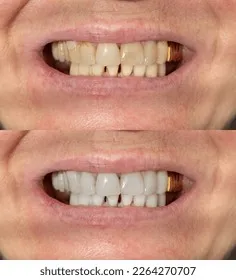What is Teeth Whitening
Teeth whitening is a cosmetic dental procedure designed to lighten the shade of your teeth and remove stains or discoloration. It’s a popular method for improving the appearance of your smile, boosting confidence, and achieving a brighter, more youthful look. The process involves using bleaching agents, typically hydrogen peroxide or carbamide peroxide, to break down stains on the enamel and dentin layers of your teeth. These stains can result from various factors, including aging, genetics, certain foods and drinks (like coffee, tea, and red wine), smoking, and certain medications. Whether you opt for professional treatments or at-home methods, the ultimate goal is to achieve a dazzling, pearly-white smile that enhances your overall appearance and self-esteem. Before you start whitening your teeth, however, it’s important to understand the various methods, benefits, and potential drawbacks to make an informed decision.
How Teeth Whitening Works
The mechanism behind teeth whitening revolves around the oxidation process. The active ingredients in whitening products, usually hydrogen peroxide or carbamide peroxide, penetrate the enamel and dentin layers of your teeth. These substances then break down the stain molecules present in these layers. The process alters the molecular structure of the stain, making it less concentrated and, consequently, less visible. This process does not remove the enamel, it simply lightens the existing tooth color. The effectiveness of the whitening process can vary depending on the concentration of the whitening agent, the duration of its application, and the type and severity of the stains. Results also depend on individual tooth characteristics such as enamel thickness and natural tooth shade. This oxidation process helps to diminish the discoloration, leading to a noticeably brighter smile. It’s a safe and effective way to refresh your smile, providing you with a boost of confidence and making you feel more comfortable and self-assured.
Teeth Whitening Methods at Home

At-home teeth whitening offers convenient and cost-effective options for achieving a brighter smile. There are several popular methods to choose from, each with its own approach and level of effectiveness. These methods allow you to whiten your teeth from the comfort of your own home, making it easier to fit into your daily routine. However, it’s important to remember that not all methods are created equal, and results can vary depending on your individual situation. Always read and follow the instructions carefully to ensure optimal results and minimize any potential side effects. When using any at-home teeth whitening product, consult with a dentist or dental professional to discuss the best options for your specific needs and assess your oral health.
Whitening Toothpaste
Whitening toothpaste is a common and readily available option. These toothpastes contain mild abrasives and chemical agents that help remove surface stains. They are generally safe for everyday use, but their whitening effects are typically subtle. Whitening toothpastes are most effective at removing stains caused by coffee, tea, and tobacco, but they won’t dramatically change the underlying color of your teeth. Continuous use can contribute to a slightly brighter smile. It is important to note that whitening toothpastes are not the same as bleaching products, so the results are not as dramatic or long-lasting. Regular use can help to maintain a brighter smile between more intensive whitening treatments, like professional cleanings or whitening strips. Always choose a toothpaste that has the American Dental Association (ADA) Seal of Acceptance, as it guarantees that the product has been tested and proven safe and effective.
Whitening Strips
Teeth whitening strips are thin, flexible strips coated with a peroxide-based whitening agent. They are applied directly to the teeth, where they remain for a specific amount of time as directed on the product packaging. Whitening strips are generally more effective than whitening toothpastes because they contain a higher concentration of the whitening agent. When using whitening strips, consistent and proper application is crucial for achieving noticeable results. Make sure to align the strips correctly with your teeth to maximize coverage. It is important to follow the instructions carefully, to avoid potential sensitivity or irritation. While these strips can deliver significant results, the effectiveness varies depending on the type of stains and the duration of use. They’re often a popular choice for their ease of use and relatively quick results, making them a convenient option for many people wanting to brighten their smiles.
DIY Whitening with Baking Soda and Hydrogen Peroxide

DIY teeth whitening with baking soda and hydrogen peroxide is a home remedy gaining popularity. This method involves mixing baking soda with hydrogen peroxide to create a paste and applying it to your teeth. Proponents claim it can help remove surface stains and brighten your smile. While some people find this approach effective, it’s important to use it with caution. Baking soda is abrasive and can potentially erode the enamel if used too frequently or aggressively. Hydrogen peroxide can cause gum irritation and tooth sensitivity. If you choose to try this method, use a very diluted mixture and do not scrub your teeth vigorously. Always consult a dentist before trying DIY teeth whitening methods to avoid potential harm to your teeth and gums. It’s always advisable to seek professional dental advice for safe and effective teeth whitening solutions. This way you can get the best results without damaging your teeth.
Teeth Whitening at Home Benefits and Drawbacks
Benefits of at Home Teeth Whitening
At-home teeth whitening offers several key advantages that make it an attractive option for many. Firstly, it provides unparalleled convenience. You can whiten your teeth in the comfort of your own home, saving time and the hassle of scheduling and traveling to a dental appointment. Secondly, at-home kits are often more affordable than professional treatments, making them a budget-friendly option for enhancing your smile. Furthermore, these methods are readily accessible. Whitening toothpastes, strips, and other products are easily available at your local pharmacy or online. At-home whitening allows for flexibility in your routine, enabling you to whiten your teeth on your schedule. You can incorporate whitening into your regular daily routine, ensuring consistent results. These benefits make at-home teeth whitening a popular choice for those seeking a brighter smile without extensive time commitment or high costs.
Drawbacks of at Home Teeth Whitening

While at-home teeth whitening is convenient, it does come with a few potential drawbacks that are important to consider. One common issue is tooth sensitivity. The whitening agents, like hydrogen peroxide, can make your teeth more sensitive to hot or cold temperatures. Gum irritation is another possible side effect. The bleaching agents can come into contact with gum tissue and cause irritation and inflammation. Moreover, the results from at-home treatments can be less dramatic and less predictable than professional whitening. It may take longer to achieve the desired shade. Also, not all stains are equally responsive to at-home treatments. Deep-seated stains may not be significantly lightened. There’s a risk of inconsistent results if the products aren’t used correctly, leading to uneven whitening. It is important to consult with a dental professional to discuss the best approach for your particular needs and oral health.
Before and After Teeth Whitening at Home Results
The before-and-after results of teeth whitening at home can vary widely depending on the method used, the severity of the stains, and the individual’s natural tooth color. Generally, you can expect to see subtle to moderate improvements with at-home treatments, especially with consistent use. Whitening toothpastes may remove surface stains, resulting in a slightly brighter smile. Whitening strips, containing a higher concentration of whitening agents, can produce more noticeable results, with teeth appearing several shades lighter over the course of the treatment. The most significant changes are often seen with stubborn stains caused by coffee, tea, or smoking. The most effective treatments often yield the most dramatic transformations. When considering at-home whitening, manage your expectations and remember that the best results often come from a combination of professional advice, consistent use, and proper oral hygiene.
Tips for Maintaining Your Whitened Smile
Maintaining your whitened smile requires a combination of good habits and preventative care. First, avoid or minimize the consumption of staining foods and drinks, such as coffee, tea, red wine, and berries. If you do consume these items, brush your teeth soon afterward. Practice excellent oral hygiene by brushing your teeth twice a day for two minutes each time. Flossing daily removes plaque and food particles, keeping your teeth clean and healthy. Use a straw when drinking beverages like soda or juices to minimize contact with your teeth. Consider using a whitening toothpaste or mouthwash to help maintain your results. Schedule regular dental check-ups and cleanings to keep your teeth healthy and remove any surface stains. Avoiding smoking and using tobacco products is crucial, as they can cause significant discoloration. Follow these guidelines to keep your smile bright and your teeth in good condition.
